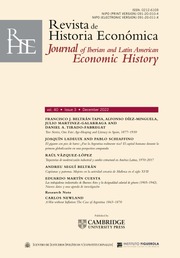REVISTA DE HISTORIA ECONOMICA
Número:
2
Publicado:

Lo más reciente
Juliana Jaramillo-Echeverri, Adriana Sofía Rodríguez
Gaurav Khanna, Carlos Alberto Medina-Durango, Anant Nyshadham, Daniel Ramos-Menchelli, Jorge Andrés Tamayo-Castaño, Audrey Tiew
Pronosticando inflaciones de canastas de alimentos desagregadas en Colombia usando un modelo XGBoost
Cesar Anzola-Bravo, Poveda-Olarte Paola
This paper explores the relationship between the physical stature of Colombians born during the 20th century and several socio-economic and demographic variables. Using a dataset of more than 225,000 individuals built with information from judicial background certificates, we found a sustained growth of the average height of women and men during the 20th century. The results show significant differences in stature according to gender, level of education, occupation, and place and date of birth. Similarly, health conditions and access to aqueducts significantly affect height. We found that departmental average height disparities decreased and the gap across regions closed throughout the century.
 Adolfo Enrique Meisel-Roca,
Adolfo Enrique Meisel-Roca, 
 Daniela Santos-Cárdenas
Daniela Santos-Cárdenas